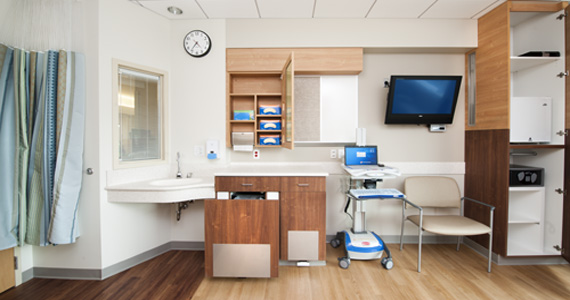
Impact of Millwork Design
When designing the interiors of a healthcare facility, there are a myriad of opportunities to create, affect and improve the experience, functionality and outcomes for all user types. The granular details are often where a design can make the greatest impact at a personal level and an intimate scale. While a micro design item such as a custom millwork cabinet may seem like a small contributor to an overall successful design, it is often representative of a much larger and meaningful design process that draws upon and influences everything from patient input to the flow of supply chains from EVS to Pharmaceutical.
By applying a rigorous and thoughtful process to the design of a healthcare facility’s millwork, we learn so much more than just what is needed in that particular piece, but begin to understand how the facility is run and how it can be improved. We learn how we, as designers, can make the most improvements from macro to micro. Because of this, the process, input and timeline involved with millwork design should be scheduled earlier and evolve with the space planning and programming as it will inform those design elements.
For example: while sitting in numerous user meetings on a gray Ohio winter day for 12 hours at a time,with staff from a large hospital system, we discuss the needs of millwork in each and every space within the impending new construction facility. The staff cycles through, for each unit or specialty department, an hour at a time. For designer and user alike, it is easy for these meetings to slip into something of a standard protocol:
‘Here is an elevation of the millwork in the space: how many drawers do you need?’ ‘Lockable or not?’ ‘Are adjustable shelves necessary?’
But as I stop and listen more intently to the answers, I hear more than just yes or no – there is hesitation in the responses, anxiety even, because to make these decisions you need more than just the nurses from the unit. In particular, as we discuss the server cabinets located outside each inpatient room the nurses let me know that in order to state how many lockable drawers they will need, the pharmacist will have to tell them what the procedure and stocking methods will be in the new facility or what the strategy is for this process as the current one is flawed. They will need to know how far away the nearest Omnicell will be, how often and how it will be stocked. The pharmacist lets me know he needs to know from the management team how accessible they want the medications to be, who should be allowed to access them and how often they will be moved. He also needs to know what his pharmacy millwork will include, how much it can hold and how they plan on facilitating the movement of the medications from the pharmacy to the unit. There were similar conversations regarding linen storage, laundering processes, etc.
This single item in this one unit of casework alone ended up requiring input from the management team, pharmacy, nurses, supply chain and scheduling; it also led to an over-arching discussion with the president of the hospital concerning the new approach to medical records and access to information and a fundamental stance of nurse station and supply closet locations. For the project mentioned about, having these millwork meetings for many types of spaces during programming and planning created and helped to inform an early design process that made it possible to realize needed adjacencies and helped the health system understand the depth and details required to plan and examine what its policies and operational goals were.
In the upcoming weeks, I will be discussing how custom millwork design affects a health system, staff, patients and families in several different settings. I will also touch on more than just the design process and its final product. Certain evidence-based design studies, if pre-formed, could further inform guiding principles and best practice that is currently lacking in some aspects of millwork design. As flexibility becomes more and more of a hot button issue, custom millwork verses customizable pre-fabricated case goods and costs associated will be considered and discussed. I hope you will keep reading!
Continue to Part 1: The Importance of Custom Millwork in an Intuitive and Responsive Healthcare Environment, Here.






The needs assessment phase is so important but, as you said, gathering the correct team to answer your questions is even more important. Very nice article and I am looking forward to the next one